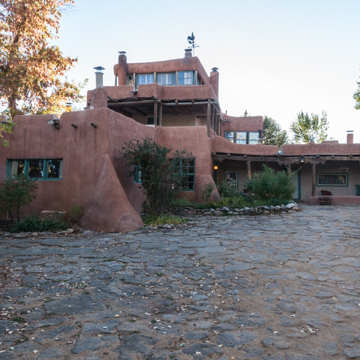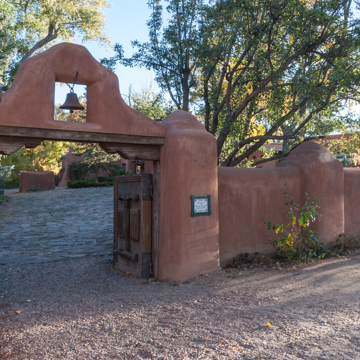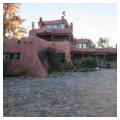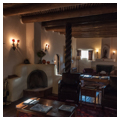You are here
Mabel Dodge Luhan House
The Mabel Dodge Luhan House embodies the utopian expectations projected onto Taos by the intellectuals, artists, and writers who came here seeking to escape the alienation of modernity. Built by a rich socialite with literary ambitions and her Native American husband, and later acquired by the actor and filmmaker Dennis Hopper, the house lays claim to an idealized—pre-modern and indigenous—authenticity of place that has made it a locus of American counterculture for nearly a century. The property abuts Taos Pueblo land, at the end of a winding dirt road that runs out from town through an arroyo; though the cottonwoods are now dense and mature, and some later constructions dot the arroyo floor, the site is largely unchanged since the early twentieth century.
The wealthy heiress of a banking family in Buffalo, New York, Mable Dodge (born Ganson in 1879) was married to her third husband, the painter Maurice Sterne, when she followed him out to Santa Fe, New Mexico, in December 1917. From 1905 until 1917, she had lived successively in Florence, Italy, and New York City, where she established a salon for the avant-garde of Greenwich Village. But what Lois Rudnick calls Mabel’s “sense of being orphaned in the twentieth century” left her feeling restless and homeless until she discovered New Mexico.
Almost immediately, Mabel’s attention gravitated north to Taos. In January 1918, she decamped there with her husband; the following May, she purchased a twelve-acre property adjoining Taos Pueblo with the assistance of Antonio (Tony) Luhan, a pueblo member. Shifting her affections, Mabel sent Sterne packing in August 1918, and married Tony in 1923.
Between 1918 and 1925, they expanded an existing four-room adobe into the seventeen-room Big House. Supervised by Tony, a construction crew from the pueblo built the house using traditional materials and methods, with thick adobe walls and roofs of vigas and latillas. The Big Room came first, added to the north side of the original structure and entered through a west-facing portico ( portal). The Big Room is divided by twisting Solomonic columns into two areas, each with its own fireplace, and it functions both as an entry hall and a living room. Above, up a precipitous staircase, bedrooms for Mabel and Tony were built along with a sleeping porch and a bathroom.
A dining room followed. Reached from the Big Room through an arched doorway down five cascading steps, it has a ceiling with latillas painted red, black, and white in a chevron pattern imitating Navajo weavings, a floor of Saltillo tiles painted in a red and black checkerboard by the artist William Penhallow Henderson, and a breakfast alcove with a clay fireplace sculpted by Tony Luhan. In 1921, a third-story sun porch was built above Mabel’s bedroom, with a panorama of the entire Taos Valley (before trees blocked the views); this was later glazed. Finally, in 1925, the Rainbow Room was added to the west of the Big Room. Entered up several steps through an ogive door, this room for reading and writing is named after its ceiling of multicolored latillas painted by the Russian émigré artist, Leon Gaspard.
Concurrently, the Big House was extended south with a long service wing and portico. Facing a flagstone courtyard, these connect to a plastered log cabin and a placita, or small courtyard with porticoes, which opens to the west. Farther south, the St. Theresa House was built as guest quarters, to one side of an entrance court framed by an existing adobe that was remodeled as a studio and garage. A gate made from a discarded balcony from the Ranchos de Taos church leads beneath a bell cote into the flagstone courtyard. The St. Theresa House was separated from the property when it was sold to Victor Higgins in 1946.
A further series of detached guesthouses were built across the arroyo to the west of the Big House: the Two-Story House, the Pink House, and the Studio. On pueblo land just beyond Mabel’s property, Tony Luhan built the eponymous Tony House for himself. There were also corrals, barns, stables, orchards, and a vegetable garden. Initially called Las Cruces, the estate was renamed Los Gallos after the Mexican ceramic roosters placed on the parapets of the Big House.
Mabel memorialized her house in Winter in Taos as a domestic haven that grew organically over time in harmony with the same cyclical rhythms of nature that regulated Taos Pueblo. In fact, the house is a complex, contradictory hybrid, compiled from the widely different worldviews of traditional Pueblo and cosmopolitan Anglo cultures. The adobe-and-timber construction and the multistory, stepped architecture make it an exemplary example of the Pueblo Revival Style. Indeed, since Tony and other members of Taos Pueblo built the house, it might even be considered a real work of pueblo architecture, rather than its stylistic imitation.
To this authenticity, however, Mabel brought not only a socially elaborate program but also such foreign elements as the Solomonic columns, the arched and ogive doorways, and the sweeping dining room stairs, all of which reflect her years spent living in Italy. Completing the effect, European furniture, tapestries, and works of art mixed with Native, Mexican, and New Mexican crafts, furniture, and rugs. As Rudnick points out, “Los Gallos was created with the Utopian intention of altering human consciousness and human relationships through the built environment. It evolved into a rather lavish hacienda with many of the ‘civilized’ comforts and human ailments of the world it claimed to reform.”
Mabel welcomed a pantheon of notables to her country estate. The sociologist John Collier lived with his family in the Two-Story House in 1920–1921, a stay that turned him into the advocate of Indian rights who, as Commissioner of Indian Affairs, would be instrumental in securing passage of the Indian Reorganization Act (1934). In 1921, Mabel invited D.H. and Frieda Lawrence to come to Taos to see “the dawn of the world.” They first visited in September 1922; on a return visit in 1924, shocked by the thought that Mabel’s generously glazed bathroom exposed her to prying eyes, Lawrence and the artist Dorothy Brett painted over its windows with multicolored designs imitating stained glass.
In 1925, Willa Cather stayed in the Pink House, where she worked on her novel of New Mexico, Death Comes for the Archbishop (1927). Georgia O’Keeffe spent the summer of 1929 in the Pink House and painted eighteen new works in the garage studio. Other visitors included the writers Aldous Huxley and Thornton Wilder, the painters Andrew Dasburg and Marsden Hartley, and the photographers Paul Strand, Ansel Adams, and Edward Weston. As much as the Taos Society of Artists, Mabel was responsible for establishing Taos an international arts colony.
Mabel’s son, John Evans, inherited Los Gallos after her death in 1962. He put the house up for sale in 1967, but when he found no buyers gave it to his daughter, Bonnie Evans, in 1968. In March 1970, she sold the house to Dennis Hopper. The actor had discovered northern New Mexico during the filming of Easy Rider (1969) and he arrived when Taos was undergoing its second countercultural renaissance as a mecca for hippies: according to the 1970 census, of the 3,314 hippies living in New Mexico, half were in Taos.
Hopper turned Los Gallos into a commune renamed the Mud Palace. Besides adding new bedrooms and bathrooms, he remodeled the entrance court garage and studio as a kitchenette apartment and converted the log cabin into an editing room. There, Hopper worked on The Last Movie (1971), a parable of the fall of the American empire that he had filmed in Peru.
Hopper saw himself as D.H. Lawrence’s successor and the inheritor of Mabel Dodge Luhan’s project of cultural reform. Yet Taos had changed since the earlier twentieth century. The hordes of uninvited freeloaders who descended on the Mud Palace forced Hopper to retreat from the Big House to the relative privacy of the Tony House. When he got into several violent confrontations with the local community, Hopper discovered that Taos was no longer accepting of Anglo outsiders who admired Pueblo Indians for being close to nature but looked down on Hispanics as rural conservatives.
In January 1978, Hopper sold the Big House to Kitty and George Otero. They renovated it as a New Age teaching and conference center called Las Palomas; to support their educational foundation, they started a bed-and-breakfast in 1984, and built a new conference center in 1990. In 1996, the property was purchased by the Attiyeh Foundation, which continues to run the Mabel Dodge Luhan House as both a conference center and bed-and-breakfast.
References
Luhan, Mable Dodge. Lorenzo in Taos. New York: Alfred A. Knopf, 1932.
Luhan, Mable Dodge. Winter in Taos. Denver: Sage Books, 1935.
Rudnick, Lois Palken. Mabel Dodge Luhan: New Woman, New Worlds. Albuquerque: University of New Mexico Press, 1987.
Rudnick, Lois Palken. Utopian Vistas: The Mabel Dodge Luhan House and the American Counterculture. Albuquerque: University of New Mexico Press, 1996.
Therein, Ellen, “Mable Dodge Luhan House/Victor Higgins House,” Taos County, New Mexico. National Register of Historic Places–Inventory Nomination Form, 1978. National Park Service, U.S. Department of the Interior, Washington, D.C.
Writing Credits
If SAH Archipedia has been useful to you, please consider supporting it.
SAH Archipedia tells the story of the United States through its buildings, landscapes, and cities. This freely available resource empowers the public with authoritative knowledge that deepens their understanding and appreciation of the built environment. But the Society of Architectural Historians, which created SAH Archipedia with University of Virginia Press, needs your support to maintain the high-caliber research, writing, photography, cartography, editing, design, and programming that make SAH Archipedia a trusted online resource available to all who value the history of place, heritage tourism, and learning.










